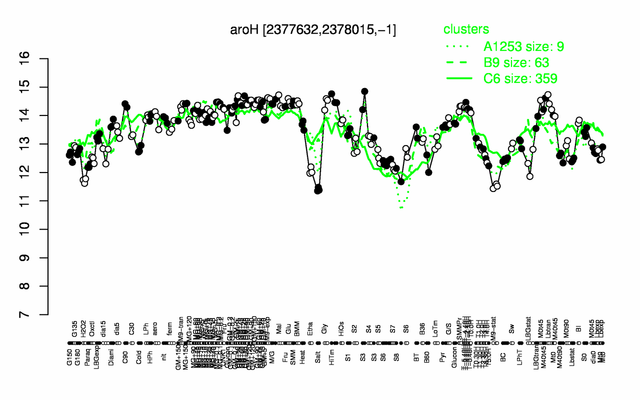Difference between revisions of "AroH"
(→References) |
|||
| Line 141: | Line 141: | ||
=References= | =References= | ||
| − | <pubmed>8378335, 25422475, </pubmed> | + | <pubmed>8378335, 25422475, 12630863 10960481 2105742 8643526 </pubmed> |
[[Category:Protein-coding genes]] | [[Category:Protein-coding genes]] | ||
Revision as of 10:31, 26 November 2014
- Description: chorismate mutase (isozymes 1 and 2)
| Gene name | aroH |
| Synonyms | |
| Essential | no |
| Product | chorismate mutase (isozymes 1 and 2) |
| Function | biosynthesis of aromatic amino acids |
| Gene expression levels in SubtiExpress: aroH | |
| Metabolic function and regulation of this protein in SubtiPathways: aroH | |
| MW, pI | 14 kDa, 5.524 |
| Gene length, protein length | 381 bp, 127 aa |
| Immediate neighbours | trpE, aroB |
| Sequences | Protein DNA DNA_with_flanks |
Genetic context 
This image was kindly provided by SubtiList
| |
Expression at a glance PubMed
| |
Contents
Categories containing this gene/protein
biosynthesis/ acquisition of amino acids
This gene is a member of the following regulons
The gene
Basic information
- Locus tag: BSU22690
Phenotypes of a mutant
Database entries
- BsubCyc: BSU22690
- DBTBS entry: no entry
- SubtiList entry: [1]
Additional information
The protein
Basic information/ Evolution
- Catalyzed reaction/ biological activity: Chorismate = prephenate (according to Swiss-Prot)
- Protein family: BCKDHA family (according to Swiss-Prot)
- Paralogous protein(s):
Extended information on the protein
- Kinetic information:
- Domains:
- Modification:
- Effectors of protein activity:
Database entries
- BsubCyc: BSU22690
- UniProt: P19080
- KEGG entry: [2]
- E.C. number:
Additional information
Expression and regulation
- Operon:
- Regulation:
- Regulatory mechanism:
- Additional information:
- number of protein molecules per cell (minimal medium with glucose and ammonium, exponential phase): 1441 PubMed
- number of protein molecules per cell (minimal medium with glucose and ammonium, early stationary phase after glucose exhaustion): 1006 PubMed
- number of protein molecules per cell (minimal medium with glucose and ammonium, late stationary phase after glucose exhaustion): 804 PubMed
Biological materials
- Mutant:
- Expression vector:
- lacZ fusion:
- GFP fusion:
- two-hybrid system:
- Antibody:
Labs working on this gene/protein
Your additional remarks
References